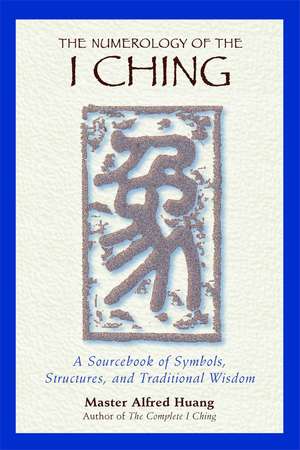The Numerology of the I Ching: A Sourcebook of Symbols, Structures, and Traditional Wisdom
Autor Taoist Master Alfred Huangen Limba Engleză Paperback – 30 iun 2000
Preț: 69.70 lei
Preț vechi: 88.71 lei
-21% Nou
13.34€ • 13.96$ • 11.10£
Carte indisponibilă temporar
Specificații
ISBN-10: 0892818115
Pagini: 192
Ilustrații: 30ill.
Dimensiuni: 152 x 229 x 30 mm
Greutate: 0.31 kg
Ediția:Original
Editura: Inner Traditions/Bear & Company
Colecția Inner Traditions
Notă biografică
Master Alfred Huang is the author of The Complete I Ching, which has been hailed as a modern masterpiece and judged by Intuition magazine to be “superior in nearly every respect” to the earlier English versions. Imprisoned and sentenced to death during China’s Cultural Revolution in 1966, Huang studied the I Ching in secret with some of that country’s greatest minds. Released in 1979, he emigrated to Hawaii, where he discovered that no accurate material on the I Ching existed in English. Since then he has devoted his life to righting that situation. He lives on the island of Maui.
Cuprins
Preface
1. The Origin and Development of the Eight Primary Gua
2. The Attributes and Symbols of the Eight Primary Gua
3. The Circular Arrangements
4. The Mysteries of He Tu and Lo Shu
5. The Mysteries of the Sixty-Four Gua
6. The Mysteries of King Wen's Sequence
7. The Hidden Meaning of the Yao
8. The Hosts of the Gua
9. The Four Most Auspicious Situations
10. The Thirty-Six Gua Most Familiar to the Chinese
11. The Judgments of Good Fortune and Misfortune
12. The Mysteries of the Mutual Gua
13. The Hidden Message of the Core Gua
14. The Origin of Fortune-Telling
15. Divination with Symbolism and Numerology
Appendix: A Brief Biography of Shao Yong
Index
Descriere
The Numerology of the I Chingis the first book to bring the complete Taoist teachings on form, structure, and symbol in the I Ching to a Western audience, and it is a natural complement to Alfred Huang's heralded Complete I Ching. It examines not only the classic circular arrangement of the eight trigrams but also the hidden numerology in this arrangement and its relationship to tai chi and the Chinese elements. Huang explains the binary code underlying the I Ching, the symbolism behind the square diagram of all 64 hexagrams, and Fu Xi's unique circular layout of the 64 hexagrams, completely unknown in the West. Entire chapters are devoted to such vital material as the hosts of the hexagrams, the mutual hexagrams, and the core hexagrams--all barely hinted at in previous versions of the I Ching. With appendices listing additional symbolism for each hexagram, formulas for easily memorizing the Chinese names of the sixty-four hexagrams, and much more, The Numerology of the I Chingis a must for serious I Ching students.
